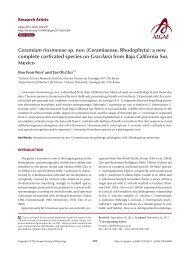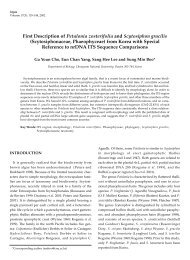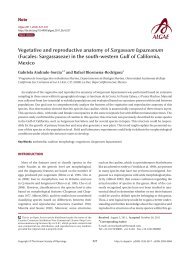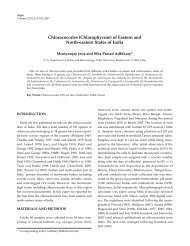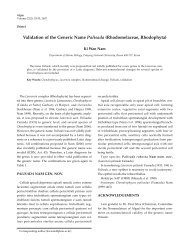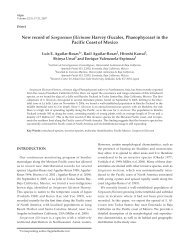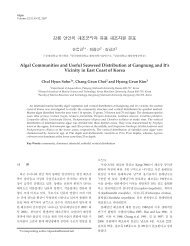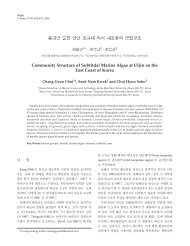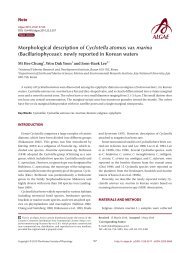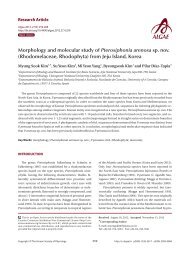New Records of Marine Algae from Korea I
New Records of Marine Algae from Korea I
New Records of Marine Algae from Korea I
Create successful ePaper yourself
Turn your PDF publications into a flip-book with our unique Google optimized e-Paper software.
not found in present study.<br />
Cutleria adspersa was similar to C. mollis and C. hancockii<br />
in having broadly fan-shaped blades developed<br />
<strong>from</strong> marginal zones <strong>of</strong> the thallus. Cutleria mollis known<br />
in Australia appeared more erect habit with s<strong>of</strong>t and<br />
thinner blade than C. adspersa (Allender and Kraft 1983).<br />
However, C. adspersa was fairly similar to C. mollis in size<br />
and thickness <strong>of</strong> the thalli; the former observed in present<br />
study was 4 cm long and 100-120 µm thick, while<br />
the latter 5 cm long and 95-125 µm thick (Allender and<br />
Kraft 1983).<br />
C. hancockii commonly occurred in the northern coast<br />
<strong>of</strong> the Gulf <strong>of</strong> California (Dawson 1944). It was distinguished<br />
<strong>from</strong> C. adspersa in having light coloured small<br />
and loosely anchored sporophyte as well as the middle<br />
to lower intertidal habitat (Dawson 1944). However,<br />
there were little differences in morphological features<br />
<strong>from</strong> the fan-shaped gametophytes <strong>of</strong> the two species<br />
(Dawson 1944). In addition, C. hancockii was occasionally<br />
collected <strong>from</strong> the subtidal area and showed much more<br />
morphological variation than the original description<br />
(Riosmena-Rodriguez et al. 2001). We could not compare<br />
Oak et al.: <strong>New</strong> <strong>Records</strong> <strong>of</strong> <strong>Marine</strong> <strong>Algae</strong> <strong>from</strong> <strong>Korea</strong> 149<br />
Fig. 4. Halarachnion latissimum Okamura.<br />
A. Carpogonial branch. B. Auxiliary cell. C. Connecting filaments (arrows) <strong>from</strong> carpogonial derivative cells. D. Gonimoblast<br />
initial and connecting filament (arrow). E, F. Gonimoblast development and connecting filaments (arrows). G. Globular cystocarps<br />
immersed under the cortical layer (Scales A-F: 10 µm, G: 50 µm).<br />
the features <strong>of</strong> sporophytes <strong>of</strong> the two species, because<br />
sporophytes <strong>of</strong> C. adspersa were not available in present<br />
study. Therefore these three species should be investigated<br />
to confirm their specific delimitations in detail.<br />
Halarachnion latissimum Okamura 1933: 9, pl. 306<br />
(Figs 3A-4G)<br />
<strong>Korea</strong>n name: 매끈곱단이 (신칭)<br />
Type locality: Enoshima, Japan<br />
Distribution: Japan (Okamura 1933; Yoshida et al.<br />
2000) and <strong>Korea</strong> (present study)<br />
Specimens examined: Pogyo, Goseong, Gyeongnam,<br />
7 II 2002 (J.H. Oak and Y.-S. Keum); Mibeob, Namhaedo,<br />
Gyeongnam, 14 III 2002 (Y.-S. Keum); Yeonampo,<br />
Pohangshi, 17 III 2002 (Y.S. Oh).<br />
Thalli were brownish red, delicately membranaceous,<br />
roundish, cuneate or subcordate with entire margin (Fig.<br />
3A-B), arising <strong>from</strong> a small basal disc, 0.7-2 mm in diameter.<br />
They were up to 20 cm long, 15 cm broad and 100-<br />
200 µm thick, and <strong>of</strong>tenly undulate to lobed in mature.<br />
Thalli were multiaxial, initiated by several apical cells,<br />
forming subterminal cells (Fig. 3C). The subterminal



